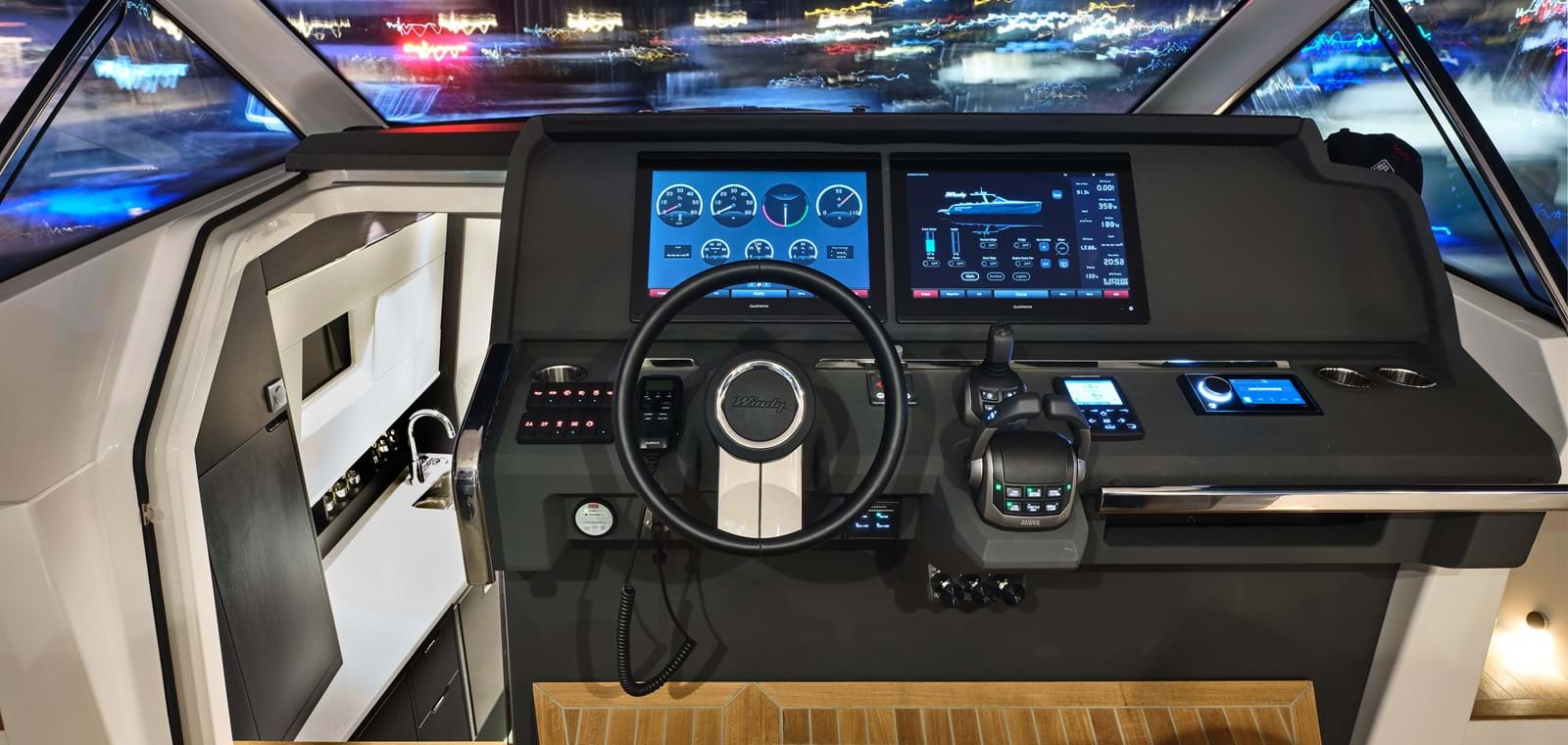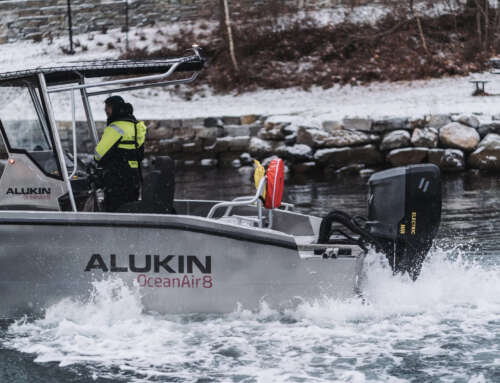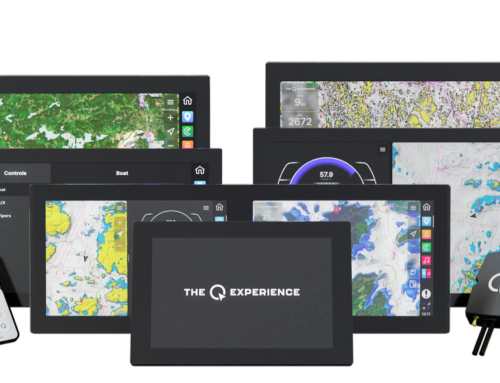What is it?
Digital switching systems are on-board power distribution and system control systems. They are based, like home automation, on industrial control systems.
A little history
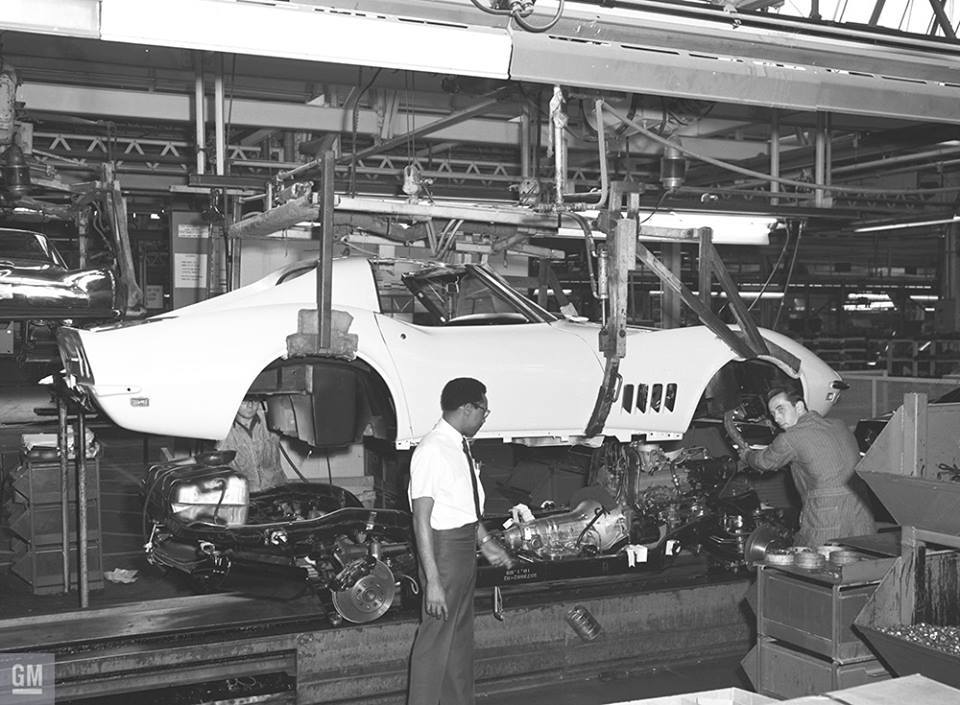
Assembling a 1969 Corvette at a GM plant
Many industries use programmable controllers to control machinery. These are small programmable computers with inputs and outputs that act based on their programming. Let’s say that instead of designing a computer to control a machine, a prefabricated one with a custom program is added to it, greatly reducing development costs. Its development dates back to the end of the 1960s, when GM required a more flexible machine control system. Since then, thanks to their versatility, flexibility and the cheapening of technology and its improvement, they are used to control and monitor processes all over the world and in all types of industries and machinery, including certain components in merchant ships and yachts. that require process automation and monitoring. This approach to a specific market has led to the specialization of the product, and there have been several companies that have released specific products for nautical.
How is the system?

It is based on one or several modules that share programming and communicate with each other. In some systems there is a module that has the programming and regulates the operation of the rest of the modules and in other systems all the modules have a copy of the program and give instructions to each other. Being a distributed system, the modules can be distributed throughout the ship. Some systems incorporate a graphical interface and can be managed from a specific screen, a tablet or a multifunction screen (the ship’s plotter), and allow monitoring and control of all the ship’s systems from it. Some of them use proprietary communication systems, others use standard systems such as nmea2000.
What advantages does it bring?
It allows a much greater monitoring, for example, it can warn us that the bilge pump automatic has turned on by itself but the bilge pump fuse is blown. Therefore, it gives us more security and control.
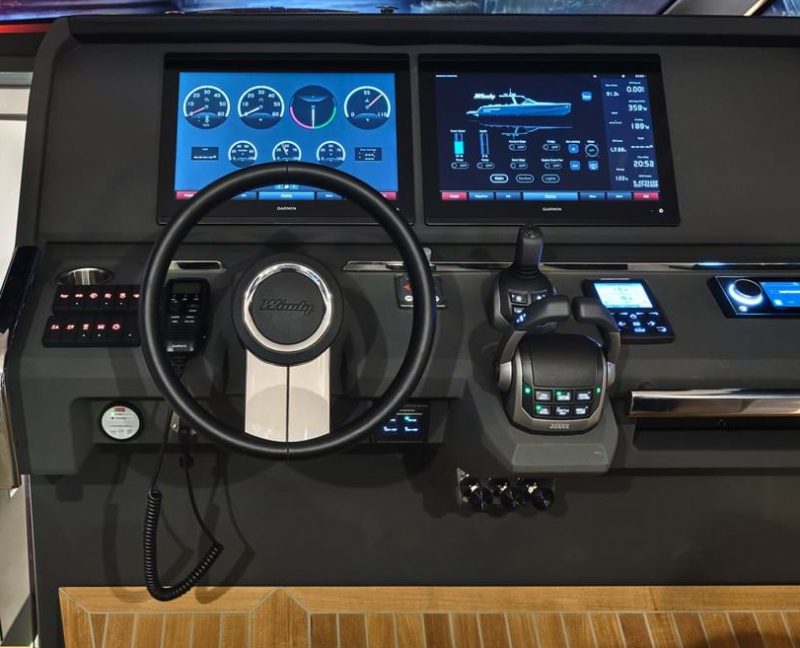
Windy 44 SR dashboard with Empirbus digital switching
It allows you to automate functions and apply logic to the circuits, for example, if the automatic bilge pump is activated for more than 3 seconds, it starts up and is maintained for a minimum of 30 seconds, and if it is active for more than 15 an alarm, and if it is at night and 30 seconds, sets off an alarm in the owner’s cabin and turns on all the lights in the cabin. Or to give another example, if the motors are at more than 1000 rpm or the temperature in the engine room rises above 45 ºC, then the fans/extractors in the engine room are activated. Therefore, it makes the ship work in optimal conditions and prevents human carelessness.
It allows to control any circuit from any point of the boat without having to carry all the wiring. Being a distributed system, wiring is much easier. For example, a circuit that is in the engine room, such as the fresh water pump, can be activated from the command post, the flybridge, the toilets, the bathing platform and finally a tablet without having to repeat the wiring. 5 or 6 times. Therefore, it saves money on complex circuitry and weight on the manufacture of the boat. Being the simplest installation, it also simplifies its maintenance and makes it more robust.
It allows the application of safety protocols, such as the hydraulic platform cannot be lowered if the engines are at more than 800 rpm or the anchor windlass or the bow thruster are deactivated above 10 knots. Such simple functions can prevent real catastrophes. Therefore, it avoids human errors.
It can be updated or modified. If at any time the shipyard decides to incorporate some improvement or functionality, or the owner wants to customize some behavior of the boat, the program can be modified to integrate the changes. Therefore, the ship can be improved.
A very interesting option in digital switching systems is the modes. These allow the boat to be adjusted according to the activity that is being carried out. There are boats that have a button depending on whether you are sailing, anchored or in the port and another one in case it is day or night, and depending on which options have been activated, the system will react by turning certain lights or circuits on or off or by regulating their intensity. Therefore, it simplifies the use of the boat.
Lastly, the possibility of using screens to control any system on the ship that is connected and the graphics that indicate their status, as well as being very useful, is very impressive. We have all the interesting data on a screen or in the palm of our hand through a tablet or smartphone. In addition, there are some that have an internet connection and can notify us if something happens or can be remotely activated to, for example, turn on the refrigerators a few hours before arriving at the ship. Therefore, it makes the ship interactive, connected and exclusive.
Is it safe? What happens if it breaks?
Yes, it is very safe. Many digital switching systems have normal fuses,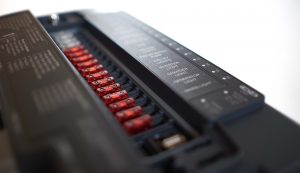 that if we activate them they work like a normal switch that offers redundancy in case something fails. Others allow you to set each output to auto/manually on/off. In many systems, if one of the modules fails, it can be replaced with another one and it automatically calibrates. In addition, many have one or a few connectors for circuits and others for communication, so they are very easy to replace. Many modules have resistance to water, and, of course, all have resistance to the salty environment. As they are common systems in high-end boats, from recognized brand systems, it is as easy to find a replacement as for any other component of the boat.
that if we activate them they work like a normal switch that offers redundancy in case something fails. Others allow you to set each output to auto/manually on/off. In many systems, if one of the modules fails, it can be replaced with another one and it automatically calibrates. In addition, many have one or a few connectors for circuits and others for communication, so they are very easy to replace. Many modules have resistance to water, and, of course, all have resistance to the salty environment. As they are common systems in high-end boats, from recognized brand systems, it is as easy to find a replacement as for any other component of the boat.
How much does it cost? Can it be put on my boat?
It depends on what we want to do. Its implementation is accelerating and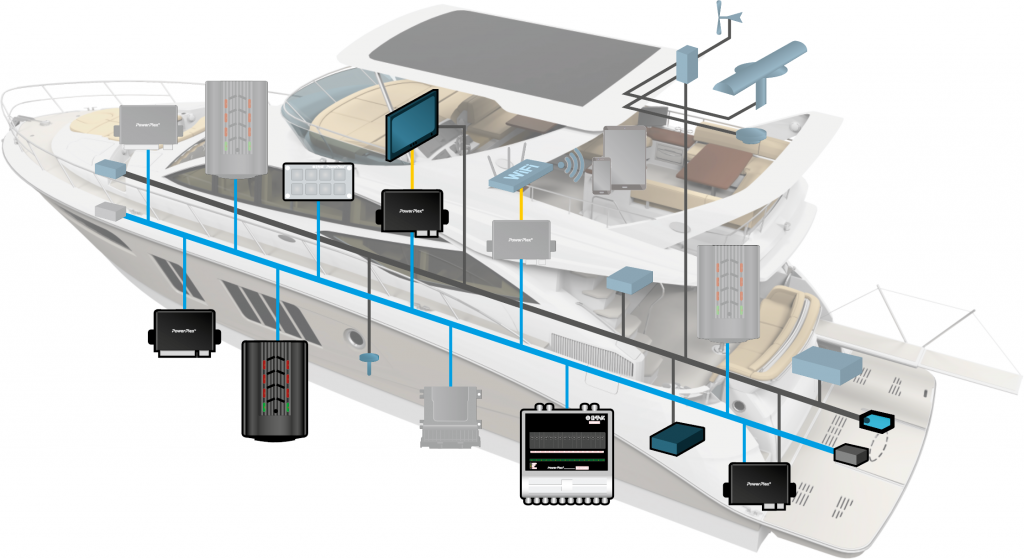 the price is going down. Manufacturers are making more and more units, and new models lower the price and increase performance. They are also bringing out new, simpler, cheaper kits suitable for virtually any boat. In new boats, the price is more attractive, since it simplifies the electrical installation and the price of the development of the “program” of the boat is distributed among all the units that use it.
the price is going down. Manufacturers are making more and more units, and new models lower the price and increase performance. They are also bringing out new, simpler, cheaper kits suitable for virtually any boat. In new boats, the price is more attractive, since it simplifies the electrical installation and the price of the development of the “program” of the boat is distributed among all the units that use it.
Yes, it can be mounted on practically any boat that is not new, although many times the limiting factor will be the price. It is necessary to count in the price the system components, the modification of the electrical system and the development of the program. If for some reason the electrical installation of the boat has to be replaced, it can be an interesting option to consider. You can also install a simple system that controls only some specific functions of the boat, and that makes the cost much cheaper. The new modules created to only turn on and off and monitor the status are cheap and will also give us information on the circuits and can be managed from the plotter.
What brands are there or are they recommended?
There are many different brands and they all have similar characteristics but also details that differentiate them. The most important thing is to buy a brand of established quality that assures us of its quality and spare parts in a few years. Today the market has matured and the main systems have been developed or bought by heavyweights in the nautical industry, which is a guarantee. Below I will list some and their characteristics.
CZone. It belongs to power products (Mastervolt, Marinco, Bep marine…) which in turn belongs to the Brunswick group (Mercury, Mercruiser, Sea Ray, Boston Whaler…). It is the most widespread system, since it was the one that previously offered compatibility with several electronic brands. It currently offers compatibility with Raymarine, Simrad, Lowrance, B&G, Garmin and Furuno displays. It is easy to program and offers a wide catalog of modules with different functions, including the manufacture on request of modules for AC. Mastervolt appliances are migrating to this system and can be controlled from it, as well as read their data or trigger alarms. Allows control via an Ipad. They also have proprietary screens to manage the system.
Empirbus. This system was recently purchased by Garmin. Developed from an industrial control system, it is a really powerful system. Its function block programming and multiple communications protocols allow it to perform highly advanced functions and communicate with virtually any device on board. The modules are solid state and the pins can be used as inputs or outputs. Initially it was the only system compatible with Raymarine, although now of course it is compatible with Garmin and Volvo’s glass cockpit displays. At the moment it does not offer AC modules, although AC circuits can be controlled by relays. It has a web server through which the plotter connects.
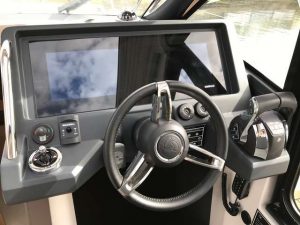
Parker Monaco with widescreen Simrad display and Naviop digital switching
Naviop. This system was purchased by Navico (Simrad, Lowrance, B&G). It is obviously compatible with screens from Simrad, Lowrance and B&G. It offers us Loop S, Loop M and Loop P packages. The first two are sold as a pack and can control up to 16 channels. With the pack comes a simple software to assign a name and a preset icon to each channel, as well as configure a screen with an image of the boat and the different modes (Loop M). The modules consist of 8 outputs, 8 replaceable relays and 8 inputs that act directly on the relay coils, allowing the use of switches or emergency activation. Loop M also shows us the location of the relays and fuses. The Loop P is their most powerful system and is reserved for shipyards. Many more modules and functions can be added and custom design can be made.
Octoplex. This system has been developed between Carlingswitch and Maretron. Carlingswitch is a world leader in the manufacture of circuit breakers and circuit breaker fuses and Maretron of sensors and monitoring of nmea2000 networks. They have recently introduced the new Octoplex lite system. This system has modules for DC and AC. The AC modules have the particularity of using resettable circuit breakers that can be activated manually, and the system tells us if they are off, on or if they have tripped. The DC modules are solid state and have inputs to directly add switches or pushbuttons. There are also nmea2000 switch modules, which use lights to indicate the status of each circuit. They are programmed using Maretron network supervision and management software nmea2000 and the system is compatible with Garmin screens, where we can see the switches and manipulate them. It has a web server through which a tablet or a PC can be connected, and remotely monitored and activated. They have proprietary screens to manage the system.
Powerplex. This system belongs to ETA, world leader in circuit protection systems. It has modules for AC and DC, and the AC module uses resettable magneto-thermal fuses. It is a highly configurable system that uses its own communication network, although it has an nmea2000 interface to connect to this network and share data. This system is compatible with Garmin, Furuno, Simrad and B&G displays. In addition, it has a web server through which the multifunction screens, or a tablet, or a PC are connected. They have proprietary screens to manage the system.
Seastar MDI. System acquired by Seastar, a world leader in aftermarket steering and engine control systems and joystick systems. It is a system for control of 12 volt circuits. It has fuses that can be used to manually activate the outputs. The system is controlled, configured and updated from a Garmin screen. The modules have 16 outputs and 16 inputs for using mechanical switches, as well as 6 analog inputs for things like tank levels, temperatures… It has native support for a remote control, which is used to turn the system on and off, as well as activate the modes or circuits that we want. The manufacturer offers customization for shipyards, and also says that it has compatibility with Iphone, Ipad and Android. It is a very new system, and I guess there will be more information soon.
Yachtdevices. This company has specialized in making very specific products for nmea2000 networks at very competitive prices. Your system, more than to do the complete wiring of a boat, I think it is indicated to create small circuits that offer solutions for little money. Its modules have many peculiarities. The relay module uses bistable relays, which only consume energy when they change state. On the other hand, it has a connection for 4 pushbuttons with LEDs to indicate their status. They are the only ones that can control both DC (12/24) and AC (230) loads. There is another module to connect remote switches, a module that controls the voltage and consumption of circuits and finally an alarm module with a speaker that can sound like a siren or play an audio file. Another particularity is that your system can be controlled and monitored from Plotters compatible with CZone, which are all brands, and its modules can be controlled by systems of other brands that use the standard nmea2000 switch control system, such as octoplex or offshore among others. others. Yacht devices offers a Wi-Fi web server that allows control from any smartphone, tablet or PC. It is programmed by pressing its buttons or software that they offer for free, although it is programmed by sending configuration statements that we must write following the manual.
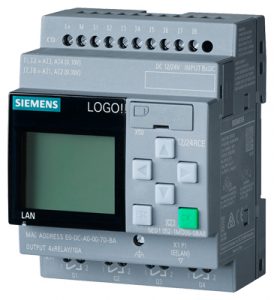
Siemens Logo, for just over €100, offers many features.
Industrial programmable controllers. Of course, we could not leave the precursors of everything. They are widely used on large ships, where there are systems made to measure for them. However, they are not recommended for medium pleasure boats for several reasons. They are designed to work with signals, not with loads, therefore we will need to use relays to activate the loads. They are not adapted to the standards used by nautical sensors. They do not use the communication protocols that are used in nautical, and therefore, they do not communicate with the plotters of any brand. They are not designed for the marine environment, they are hard, since they are prepared for industrial environments, but on a boat they may need extra protection. Even so, their low price, robustness, ease of finding a spare part and programming power, much higher than many nautical systems, can make them a good option to control certain circuits or machines at a very competitive price. In addition, there are so-called programmable relays, which are simpler versions, but offer an impressive price/performance ratio, and higher computing power than is necessary in many applications. An example would be an alternating current source selector, which by means of buttons, we can choose which source we want (generator, port or inverter, or between one generator and another), or it can work automatically.

